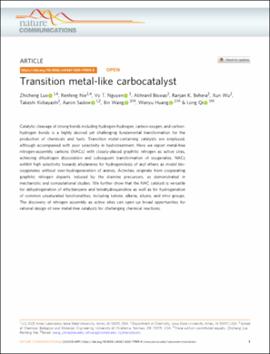| dc.contributor.author | Luo, Zhicheng | |
| dc.contributor.author | Nie, Renfeng | |
| dc.contributor.author | Nguyen, Vy T. | |
| dc.contributor.author | Biswas, Abhranil | |
| dc.contributor.author | Behera, Ranjan K. | |
| dc.contributor.author | Wu, Xun | |
| dc.contributor.author | Kobayashi, Takeshi | |
| dc.contributor.author | Sadow, Aaron | |
| dc.contributor.author | Wang, Bin | |
| dc.contributor.author | Huang, Wenyu | |
| dc.contributor.author | Qi, Long | |
| dc.date.accessioned | 2021-04-21T15:41:03Z | |
| dc.date.available | 2021-04-21T15:41:03Z | |
| dc.date.issued | 2020-08-14 | |
| dc.identifier.citation | Luo, Z., Nie, R., Nguyen, V.T. et al. Transition metal-like carbocatalyst. Nat Commun 11, 4091 (2020). https://doi.org/10.1038/s41467-020-17909-8 | en_US |
| dc.identifier.uri | https://hdl.handle.net/11244/329483 | |
| dc.description.abstract | Catalytic cleavage of strong bonds including hydrogen-hydrogen, carbon-oxygen, and carbon-hydrogen bonds is a highly desired yet challenging fundamental transformation for the production of chemicals and fuels. Transition metal-containing catalysts are employed, although accompanied with poor selectivity in hydrotreatment. Here we report metal-free nitrogen-assembly carbons (NACs) with closely-placed graphitic nitrogen as active sites, achieving dihydrogen dissociation and subsequent transformation of oxygenates. NACs exhibit high selectivity towards alkylarenes for hydrogenolysis of aryl ethers as model bio-oxygenates without over-hydrogeneration of arenes. Activities originate from cooperating graphitic nitrogen dopants induced by the diamine precursors, as demonstrated in mechanistic and computational studies. We further show that the NAC catalyst is versatile for dehydrogenation of ethylbenzene and tetrahydroquinoline as well as for hydrogenation of common unsaturated functionalities, including ketone, alkene, alkyne, and nitro groups. The discovery of nitrogen assembly as active sites can open up broad opportunities for rational design of new metal-free catalysts for challenging chemical reactions. | en_US |
| dc.description.sponsorship | The Ames Laboratory is operated for the U.S. DOE by Iowa State University under Contract No. DE‐AC02‐07CH11358. The computational simulations were performed at the OU Supercomputing Center for Education and Research and the National Energy Research Scientific Computing Center (NERSC), a U.S. Department of Energy Office of Science User Facility, and were supported by the U.S. Department of Energy, Basic Energy Sciences (Grant DE-SC0020300).
Open Access fees paid for in whole or in part by the University of Oklahoma Libraries. | en_US |
| dc.language | en_US | en_US |
| dc.rights | Attribution 4.0 International | * |
| dc.rights.uri | https://creativecommons.org/licenses/by/4.0/ | * |
| dc.subject | Catalyst Synthesis | en_US |
| dc.subject | Chemical Engineering | en_US |
| dc.subject | Heterogeneous Catalysis | en_US |
| dc.title | Transition metal-like carbocatalyst | en_US |
| dc.type | Article | en_US |
| dc.description.peerreview | Yes | en_US |
| dc.identifier.doi | 10.1038/s41467-020-17909-8 | en_US |
| ou.group | Gallogly College of Engineering::School of Chemical, Biological and Materials Engineering | en_US |

